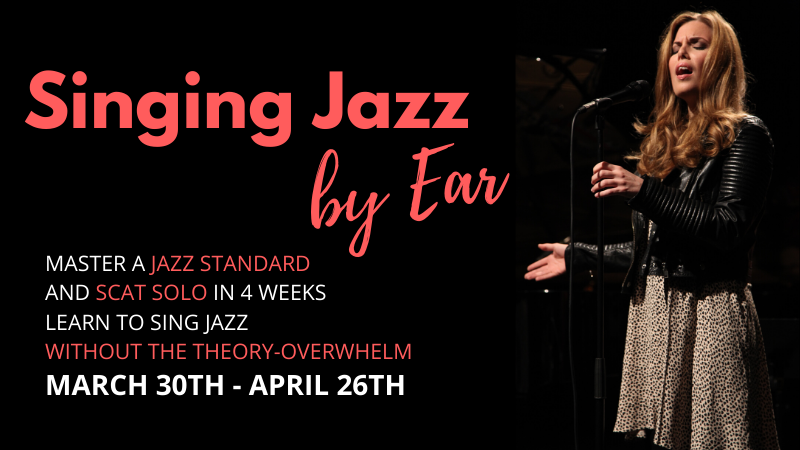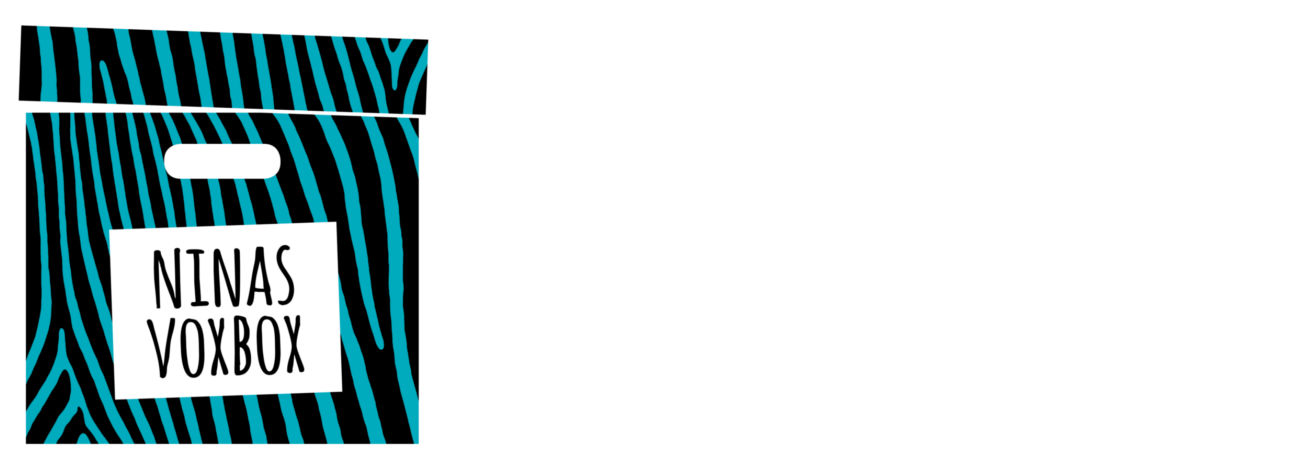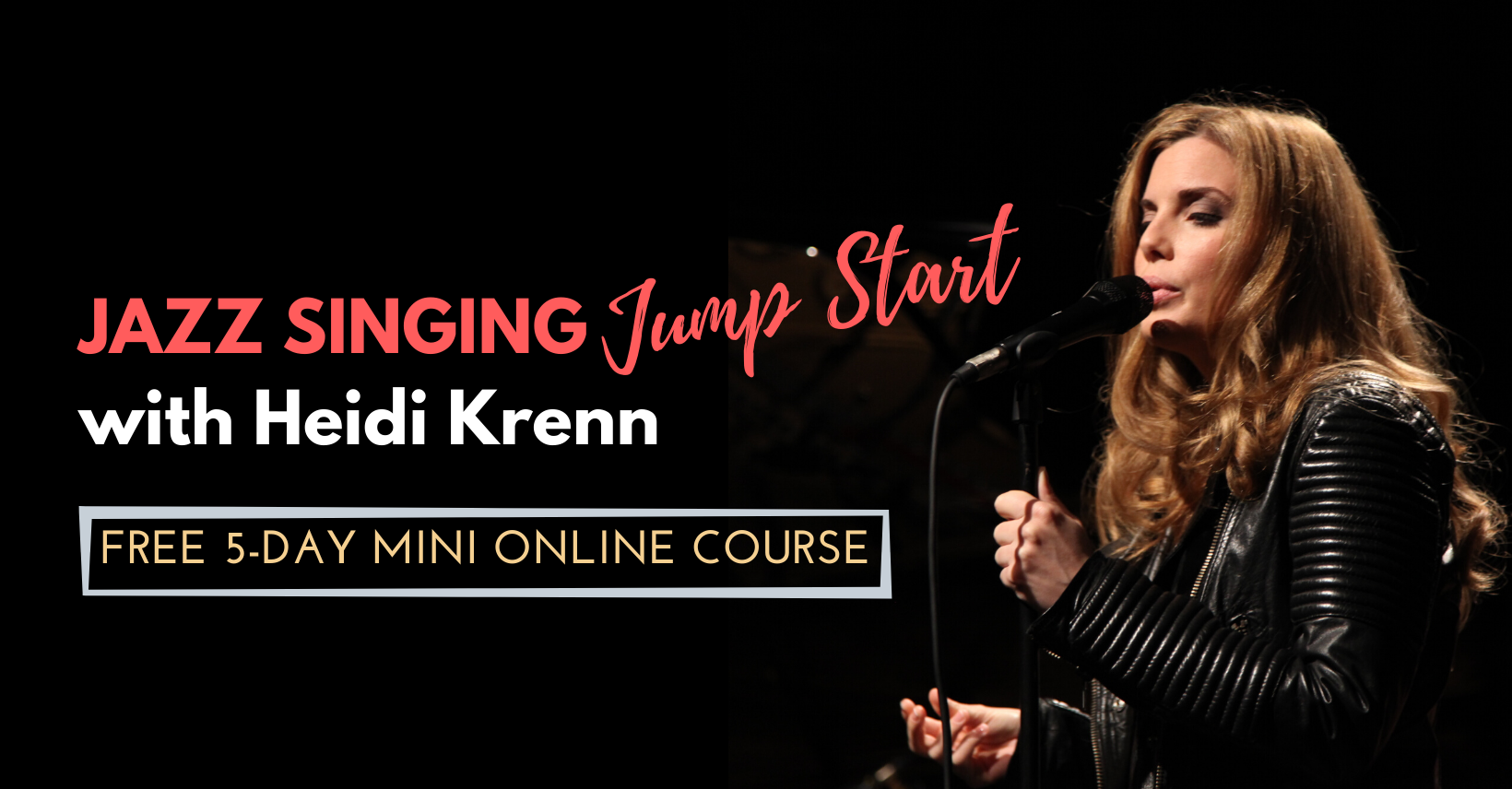Last week I signed for the Facebook online course „Jazz Singing Jump Start“. It was a free 5-day mini course which lasted 20 minutes each day, every morning at 10 o’clock via Zoom. Each evening, there was a Q&A session also. It was organized and held by the austrian jazz singer Heidi Krenn. In this article, I would love to tell you what I learned this week. I loved this course very much – Heidi did a fantastic job!!
Lesson 1: It’s all about the melody
It was about learning the song the way it was written by the composer. I learned that there are two important principles in jazz: Respect the elders and learn from them. Then I can go and add my own take on it. To really know a song, I first must internalize it in its purest form – without anyone else’s interpretation interfering. Only then I can recognize and appreciate what others have done with it.
We learned the song „Sometimes I’m happy“. First we had to listen the recording and take a look at the music, she explained the structure of the song. Then we had to hum and sing along until we felt we know it. We repeated again and again in the video. Singing with her, withour her, only with chords, then a cappella. Till the next day, we had to prepare it by heart.
Lesson 2: Getting to the root of it
We learned the roots of the bass part of our song from yesterday. Crazy, I’ve never done this before with a song. I learned, that as a jazz singer it is really important to not only know the melody, but also to know what lies underneath of it. This structure has to get into my ear, so that I then better already hear with my inner ear for my intuitive system. Then I will have a greater chance even just by ear to pick notes that fit. The best way to breaking down the harmony is to singing the roots. The roots created a simple bass line that is a melody of its own. And we learned this bass line with exact the same steps that we used when learning the melody of the song yesterday.
Lesson 3: Active Listening
We continued the jazz lesson with Active Listening. Heidi told us, that one of the most important skills we must learn as musicians is active listening. There’s a difference between enjoying a recording or giving it my full attention. Heidi showed us how to learn to appreciate other’s creativity and at the same time learn the style by listening to the greats. It trains our inner ear and gives us the ability to find our way back when we get lost when we start improvising or need to come back in after someone else’s solo.
With this, we should basically acquiring a taste – we learn the jazz language and swing feel and at the same time discover what we like and what we don’t. This will inform our artistry immensely! So she said!!
We listend to two versions of our song. One from Sarah Vaughan, the other from Carmen McRae. We should follow the original melody in our head while listening. And also do this with the roots. Both singers added a lot of things. The homework till the next day was to find out how many choruses they are singing, printing many copies of the chords art and filling in what we hear.
Listening to the greats should be THE way to learn a style or how to swing. And the cheapest, Heidi said. She advised us to stand quality time with a record in our future. The more we give, the more we get back, she said.
Lesson 4: What we can learn from instrumentalists
We listened to instrumentalists, I learned a lot! In jazz singers are strongly influenced by instrumentalists. One of the fathers of jazz was even both – singer and trumpet player: Louis Armstrong. He was a huge influence on Billie Holiday and Ella Fitzgerald and even recorded with both of them. Heidi told us, that we cannot ignore this essential part of the jazz singing tradition if we truly want to learn the style.
Heidi brought our attention to a similar figure in the bebop era that was an equally strong inspiration for scat singers: Dizzy Gillespie. We listened to a lot parts of recordings to see how singers have tried to adapt to his style and used it in their own singing. At every video, she explained a litte bit. We listened to:
Dizzy Gillespie: Oo Bop Sh’Bam
Betty Roché referencing Dizzy Gillespie in her solo on Take The A-Train
Dizzy Gillespie & Kenny Hagood: Ool-Ya-Koo
Ella Fitzgerald: Ool-Ya-Koo
Sarah Vaughan: Shulie a Bop
Heidi gave us also names of other great instrumentalists to listen to the next days: Dizzy Gillespie, Charlie Parker, Miles Davis, Chet Baker, Dexter Gordon, John Coltrane, Bill Evans, Barry Harris, Oscar Peterson and Art Farmer.
Now our homework was to find instrumental recordings of „Sometimes I’m Happy“ and trying to transcribe some bits we find most interesting. That was really ambitous…
Lesson 5: Call and Response
The last session was about Call and Response. It was very much like a conversation with Heidi. We started following Heidi’s call first answering with the melody, then repeated her scat, finally tried to made up our own improvisation. But we had to follow the melody and the roots while doing this. She said that this is a musical dialogue which we can have with anyone else.
And then there was an additional ending session. Heidi told us about three big mistakes to avoid when making a jazz standard our own:
1) wrong repertoire & keys
2) only copying others without making it my own
3) scatting without knowing the harmony
Her conclusion: If we can hear it, we can sing it.
Interested in Heidi’s next course? It will be „Singing Jazz by Ear – Master a jazz standard and scat solo in 4 weeks. Learn to sing jazz without the theory-overwhelm.“ It will be held online from March 30th to April 26th, 2020.

Please join if you are interested – Heidi is the perfect online teacher!
www.heidikrenn.com




